University of Mumbai
The University of Mumbai, informally known as Mumbai University (MU) is a collegiate public state university located in Mumbai, Maharashtra. It offers bachelors, masters and doctoral courses, as well as diplomas and certificates in many disciplines like the Arts, Commerce, Science, Medical and Engineering. The language of instruction for most courses is English.
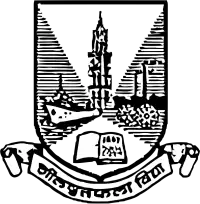 | |
| Motto | Śīlaṣṭataphalā Vidyā (Sanskrit) |
|---|---|
Motto in English | The Fruit of Learning is Character and Righteous Conduct |
| Type | Public |
| Established | 18 July 1857 |
| Chancellor | Governor of Maharashtra |
| Vice-Chancellor | Suhas Pednekar[1] |
| Students | 7,579[2] |
| Undergraduates | 1,459[2] |
| Postgraduates | 5,638[2] |
| Location | , , India 18°58′30″N 72°49′33″E |
| Campus | Urban All Campuses: 250 acres (1,000,000 m2)[3] |
| Colours | Saffron[4] |
| Affiliations | UGC, NAAC, AIU |
| Website | mu |
The University of Mumbai was established in 1857. The university has two campuses across Mumbai (Kalina Campus and Fort Campus) and two in the MMR region, one of them being Thane Sub Campus and the other being Kalyan Sub Campus. The Fort campus carries out administrative work only. Several institutes in Mumbai previously affiliated to the university are now autonomous institutes or universities.
The University of Mumbai is one of the largest universities in the world.[5] The university in 2013 had 711 affiliated colleges.[6] Ratan Tata is the appointed head of Mumbai University's advisory council.[7]
History

In accordance with "Wood's despatch", drafted by Sir Charles Wood in 1854, The University of Bombay was established in 1857 after presentation of a petition from the Bombay Association to the British colonial government in India.[8] The University of Mumbai was modeled on similar universities in the United Kingdom, specifically the University of London.[8]:188
The first departments established were the Faculty of Arts at Elphinstone College in 1835 and the Faculty of Medicine at Grant Medical College in 1845.[8] Both colleges existed before the university was founded and surrendered their degree-granting privileges to the university. The first degrees awarded in 1862 were Bachelor of Arts and Licentiate in Medicine.[8]
Initially, the Town Hall in Mumbai was used as the university's offices.
Cornelia Sorabji, who later studied law at Somerville College becoming Oxford's first female law student and India's first female advocate, was the university's first female graduate in 1888.[9][10]
Until 1904, the university only conducted examinations, awarded affiliations to colleges, developed curricula and produced guidelines for colleges developing curricula.[8] Teaching departments, research disciplines and post-graduate courses were introduced from 1904 and several additional departments were established. After India achieved independence in 1947, the functions and powers of the university were re-organised under The Bombay University Act of 1953.[11] The name of the University was changed from University of Bombay to University of Mumbai in 1996.[12]
In 1949, student enrollment was 42,272 with 80 affiliated colleges. By 1975, these numbers had grown to 156,190 and 114 respectively.[8]
Campuses
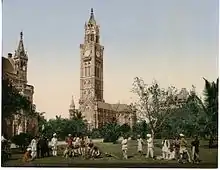
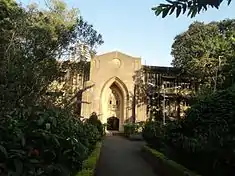
Kalina Campus
The Kalina campus in suburban Mumbai covers an area of 93 hectares (230 acres) and houses graduate training and research centres. Departments offering courses in the sciences, technology, commerce, and humanities are located here. Most colleges of engineering and medicine affiliated to the University of Mumbai, though, are privately owned. The university does not have its own engineering or medicine departments.
Centres and institutes located in the Kalina Campus include:
- Examination House, also known as Mahatma Jyotirao Phule Bhavan houses the office of the Controller of Examinations. Centralized assessment of answer books for various departments is carried out in a separate four-storey annexe. Examination processes were made more efficient by the introduction of online delivery of question papers for examinations, and assessment of answer books by scanning at remote examination centres. The academic depository of the university was started in collaboration with CDSL in 2015. The university is the first university in the country to start an academic depository.[13]
- National Centre for Nanosciences and Nanotechnology – a research facility
- Department of Biophysics – the only such department in western India
- Jawaharlal Nehru Library[14][15]
- Garware Institute of Career Education and Development, whose courses include medical transcription and management courses such as agriculture business management, pharma management and tourism management
- MAST (मस्त) FM, the campus radio station of the university operating at 107.8 MHz frequency modulation
- Alkesh Dinesh Mody Numismatic Museum which houses displays of currency from around the world
- Alkesh Dinesh Mody Institute for Financial and Management Studies (ADMI) which offers BMS, MFSM and MMS programmes[16]
- Department of Extra Mural Studies which conducts weekend courses in many disciples including astronomy, astrophysics, plant and animal taxonomy, hobby robotics, and hobby electronics
- The Institute of Distance and Open Learning (IDOL) which offers courses in humanities, sciences, commerce, computer science, and information technology
- Western Regional Instrumentation Centre (WRIC) – a research and training facility for instrumentation engineering and science
- Centre for African Studies
- Centre for Eurasian Studies
- A rose garden where more than a hundred varieties of rose have been cultivated
- Marathi Bhasha Bhavan Centre which conducts academic and cultural activities associated with the Marathi language
Thane Campus
The Thane Campus, established in 2014, spans an area of 2.4 ha (6 acres) and is a modern, two-storey complex. It houses administrative offices, the School of Law, University of Mumbai and also undertakes management courses.
Fort Campus
The University of Bombay was established in 1857 at the Fort campus, which is located near the southern end of Mumbai island. It houses the administrative division of the university on a 5.3 ha (13 acres) site. It has 116,000 m2 (1.25×106 sq ft) of built-up area, 2,000 m2 (22,000 sq ft) of classrooms, and 7,800 m2 (84,000 sq ft) of laboratory space. There are two post-graduate centres, 354 affiliated colleges, and 36 departments. It is built in the Gothic style and the Rajabai Clock Tower stands on the lawns of the campus.
Kalyan Campus
After a long delay since planning of a sub-campus for Kalyan in 2007, the University of Mumbai started a campus in Kalyan in 2019.
Library
The university library was designed by Sir George Gilbert Scott at the same time as the Rajabai Clock Tower. It is today part of the Victorian complex in Mumbai that is recognised as a UNESCO World Heritage Site.
Rajabai Clock Tower

One of Mumbai's landmarks, the Rajabai Clock Tower was completed in the 1870s and houses the University of Mumbai's library. Sir George Gilbert Scott modelled the Rajabai Clock Tower on the clock tower of the Palace of Westminster in London.[17] Local businessman Premchand Roychand contributed to the cost of construction and named the tower in memory of his mother, Rajabai. The tower is 85 m (280 ft) tall and has five storeys. At a height of 9.1 m (30 ft) from the ground, there are eight statues representing the Indian castes. The tower clock is reported to have played 16 tunes including "Rule Britannia", "God Save the Queen", "Home! Sweet Home!" and "A Handel Symphony".[18] On the initiative of the then Vice-Chancellor, Dr. Rajan Welukar, the first phase of restoration of Rajabai Clock Tower started in 2013 and was completed in May 2015. Tata Consultancy Services (TCS) gave a Rs 4 crore grant for this phase of the restoration project.[19]
Convocation Hall
The Cowasji Jehangir Convocation Hall was designed by Sir George Gilbert Scott and is today part of the Victorian complex, north of Oval Maidan, that is a UNESCO World Heritage Site.
Ratnagiri Campus
This minor campus, running mostly extramural courses, is located in the town of Ratnagiri.
Faculties and departments
The University of Mumbai has several hundred affiliated colleges offering undergraduate and postgraduate education, and conducting research in areas of science, commerce, arts, engineering, management, law, etc. Each college has its own campus and specialized departments/centres.
Prominent institutes
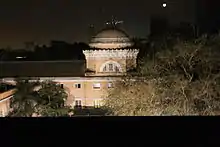
Several departments of the University of Mumbai are located away from the four Mumbai campuses. These include the departments of Medicine and Medical Research located in several prominent hospitals in Mumbai, such as the Tata Memorial Hospital, Bombay Hospital and G.S. Medical College and King Edward Memorial Hospital. Institute of Chemical Technology (then known as the University Department of Chemical Technology, UDCT), was originally an institution of MU, but later gained university status.[20] Tata Memorial Hospital is now affiliated to the Homi Bhabha National Institute.
Similarly, Veermata Jijabai Technological Institute was the first Engineering Institute in the University of Mumbai (1887)[21] and Thadomal Shahani Engineering College was the first Engineering college in the University of Mumbai to start courses in Computer Engineering, Information Technology, Electronics Engineering and Biomedical Engineering. Sardar Patel College of Engineering is another engineering college affiliated to the University .[22] Further, K.J. Somaiya College of Engineering is additional engineering college affiliated to the University. Along with these, Fr. C. Rodrigues Institute of Technology, D.Y.Patil's Ramrao Adik Institute of Technology & SIES Graduate School of Technology are also affiliated to the University of Mumbai.
The Jamnalal Bajaj Institute of Management Studies was established in 1965 in collaboration with Stanford Graduate School of Business of Stanford University. Sophia College for Women was established in 1941.
Libraries
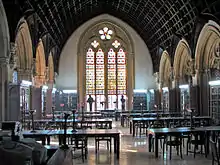
Jawaharlal Nehru Library (JNL) is the central library, located on the campus at Kalina. As of May 2019, it desperately needs restoration.[23]
The technology and applied research journals and books of the University of Mumbai are kept in the libraries of the Institute of Chemical Technology, Tata Institute of Fundamental Research, Jamnalal Bajaj Institute of Management Studies and Tata Memorial Hospital.
Sports
The university's cricket team is the most successful in the Rohinton Baria Trophy, with 28 wins.
Vice-Chancellors
- John Wilson – 1857
- Raymond West
- Alexander Kinloch Forbes
- Sir Alexander Grant, 10th Baronet – 1863–1868
- William Guyer Hunter – 1869
- Herbert Mills Birdwood
- Rev Dugald Mackichan – 1888-91
- Kashinath Trimbak Telang – 1892–1893
- Ramkrishna Gopal Bhandarkar – 1893–1894
- N. G. Chandavarkar – 1911−1912
- John Heaton – 1912–1915
- Pherozeshah Mehta – 1915
- Sir Leslie Orme Wilson (Chancellor) - 1927
- Mirza Akbar Khan – 1930–31
- R. P. Paranjpe – 1934
- Sir Rustom Pestonji Masani - 1941
- Pandurang Vaman Kane
- John Matthai – 1955–1957
- V. R. Khanolkar – 1960–1963
- Shashikant Karnik
- Trimbak Krishna Tope – 1971–1977
- M. D. Bengalee – 1986
- Snehlata Deshmukh – 1995–2000
- Bhalchandra Mungekar – 2000–2005
- Vijay Khole – 2005 – September 2009
- Chandra Krishnamurthy – September 2009–July 2010, Acting Vice-Chancellor
- Rajan Welukar – July 2010 – July 2015
- Sanjay V. Deshmukh – July 2015 – October 2017[24]
- Dr. Suhas Pednekar - April 2018 − Present
Notable alumni
Ranking
| University and college rankings | |
|---|---|
| General – international | |
| QS (World) (2020)[25] | 801–1000 |
| QS (Asia) (2020)[26] | 177 |
| QS (BRICS) (2019)[27] | 89 |
| General – India | |
| NIRF (Overall) (2020)[28] | 95 |
| NIRF (Universities) (2020)[29] | 65 |
Internationally, the University of Mumbai ranked 801–1000 by the QS World University Rankings in 2020,[25] 177 in Asia in 2020[26] and 89 among BRICS nations in 2019.[27]
The National Institutional Ranking Framework (NIRF) ranked it 65th among universities in India in 2020.[29]
Partner universities
Memoranda of Understanding (MoUs) have been signed with University of Amsterdam, University of Bath, Liverpool Hope University, Ryerson University, IESEG School of Management, Tianjin University of Technology, Tianjin University, Nankai University in China and Edith Cowan University in Australia.[30]
See also
- List of universities in India
- Universities and colleges in India
- List of universities by number of billionaire alumni
- Education in India
References
- "Hon'ble Vice Chancellor". mu.ac.in. Mumbai University. 22 July 2014. Retrieved 3 May 2018.
- "University Student Enrollment Details". www.ugc.ac.in. Retrieved 10 February 2020.
- "Campus".
- "Mumbai University - Colours".
- "Mumbai University records 60% rise in students" : DNA – Daily News and Analysis newspaper article, Monday, 21 March 2011.
- With 811 colleges, Pune varsity 2nd largest in country The Times of India newspaper article : 4 November 2013
- "Ratan Tata to head Mumbai University's first advisory council".
- Aroon Tikekar (2006). The Cloister's Pale: A Biography of the University of Mumbai (2nd ed.). Mumbai: Popular Prakashan. ISBN 978-81-7991-293-5.
- First lady – Moneylife Archived 22 February 2014 at the Wayback Machine
- "University strengthens ties with India". Cherwell. 13 December 2012. Archived from the original on 22 February 2014.
- Ṭikekara, Aroon (2006). The Cloisters Pale (2nd ed.). Mumbai: Popular Prakashan. p. 327. ISBN 978-817991293-5.
- Government of Maharashtra Gazette 4 September 1996
- "Data" (PDF). www.cdslindia.com.
- Karangutkar, Suyash (21 May 2019). "Varsity officials inspect dilapidated library". The Hindu. ISSN 0971-751X. Retrieved 1 September 2019.
- Karangutkar, Suyash (13 May 2019). "In Mumbai University's Jawaharlal Nehru Library, no peace of mind". The Hindu. ISSN 0971-751X. Retrieved 1 September 2019.
- "Alkesh Dinesh Mody Institute". Mu.ac.in. Retrieved 31 January 2012.
- "Rajabai Tower Mumbai: Tourist Attractions in Mumbai". Mumbailocal.Net. 7 November 2010.
- "Clocktower chimes". Deccan Herald. 22 April 2017.
- "Mumbai's iconic Rajabai Clock Tower reopens after renovation".
- "Archived copy". Archived from the original on 17 May 2013. Retrieved 14 November 2014.CS1 maint: archived copy as title (link)
- "Archived copy". Archived from the original on 21 September 2013. Retrieved 19 September 2013.CS1 maint: archived copy as title (link)
- "..:: Directorate of Technical Education, Maharashtra State, Mumbai ::." www.dtemaharashtra.gov.in. Archived from the original on 1 September 2015. Retrieved 13 April 2018.
- Karangutkar, Suyash (13 May 2019). "In Mumbai University's Jawaharlal Nehru Library, no peace of mind". The Hindu. ISSN 0971-751X. Retrieved 13 May 2019.
- "Hon'ble Vice Chancellor". mu.ac.in. 22 July 2014. Retrieved 13 April 2018.
- "QS World University Rankings 2020". QS Quacquarelli Symonds Limited. 2019. Retrieved 1 October 2019.
- "QS Asia University Rankings 2020". QS Quacquarelli Symonds Limited. 2020.
- "QS BRICS University Rankings 2019". QS Quacquarelli Symonds Limited. 2018.
- "National Institutional Ranking Framework 2020 (Overall)". National Institutional Ranking Framework. Ministry of Education. 11 June 2020.
- "National Institutional Ranking Framework 2020 (Universities)". National Institutional Ranking Framework. Ministry of Education. 11 June 2020.
- "Indian students should consider studying in China". Hindustan Times. 29 November 2011. Archived from the original on 14 January 2012. Retrieved 31 January 2012.